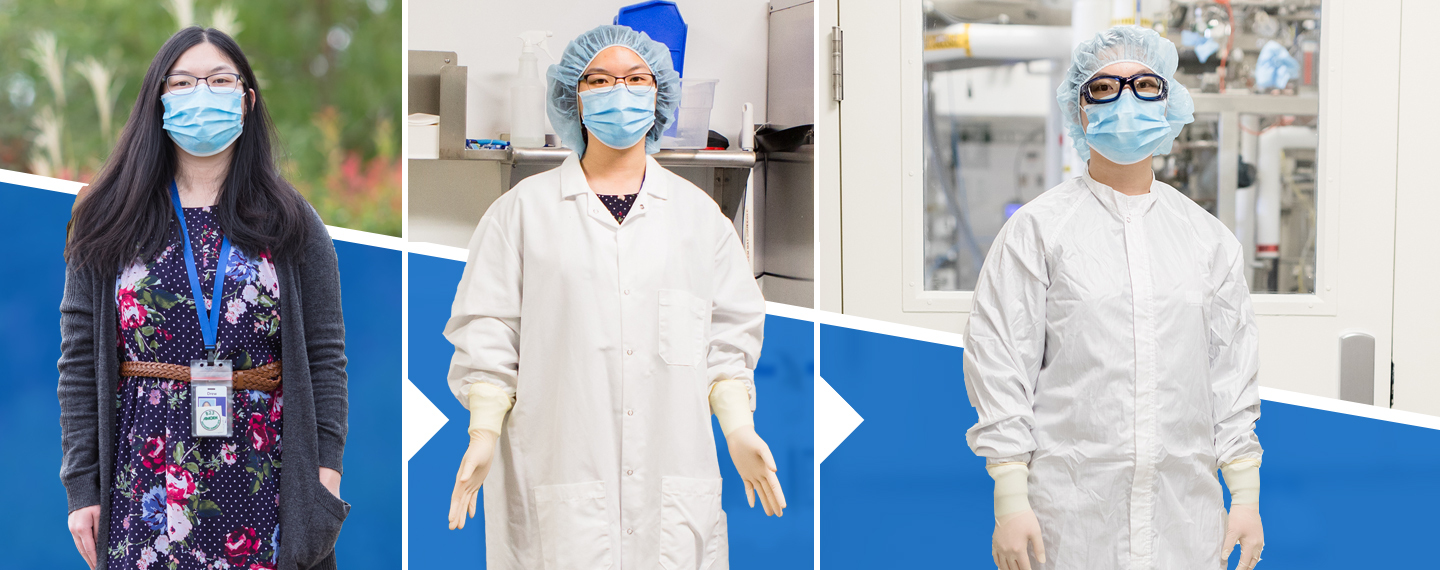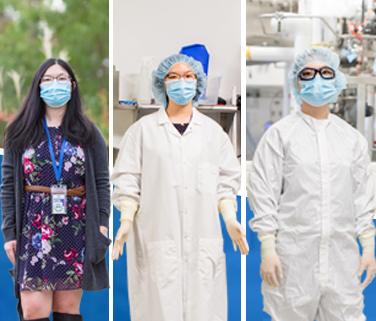Sit at your desk. Power up your laptop. That might be how your workday starts. Not so for thousands of essential workers at Amgen who work in biotechnology manufacturing. Getting into a facility where these medicines are made involves an elaborate process—one further complicated by COVID-19.
Drew Liu stood at the epicenter where Amgen raises cells that become medicines. To reach this hyper-clean area required layers of personal protective equipment, repeated sanitization of hands and gloves and, preferably, an empty bladder.
“Every once in a while, you’ll have to go to the bathroom,” Liu said. “But you try to prevent that from happening by going beforehand. Because if you go, you have to go through the whole process of gowning up again. And it can be a real hassle.”
Few in the manufacturing world of Amgen would argue with her.
Liu works in what some would call Amgen’s lifeblood – the making of protein-based therapies that end up helping sick people all over the world. Every single day in Liu’s world, millions and millions of cells are stored, agitated and gently massaged in sterile liquid and grown in bioreactors. Then the protein is isolated from the cell and ultimately makes its way to vials or syringes to be packaged and made available to the public.
That’s a lay-person’s explanation of what can loosely be described as biotechnology manufacturing—an activity that’s far more involved than, say, the manufacturing pills. It’s what is taking place constantly at multiple Amgen manufacturing facilities around world under precise monitoring.
While some employees at Amgen focus on research in labs, and others work in external roles interfacing with physicians, Liu’s is part of a large population of employees at Amgen focused on safely and reliably manufacturing and delivering a global population of patients with Amgen medicines.
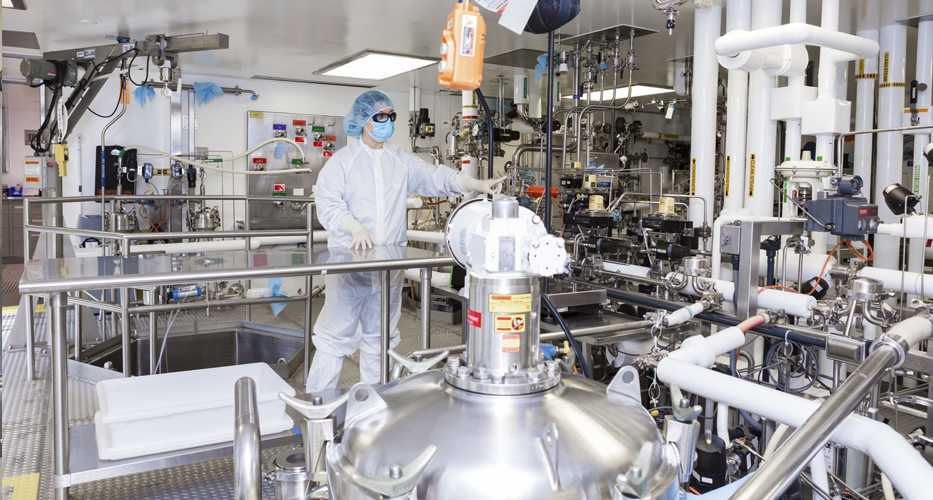
Drew Liu stands on an elevated platform near a cell storage tank inside Amgen's manufacturing facility in Thousand Oaks. Photo: Stacy Gleason.
At no point can any part of the process be compromised by contamination, which means every person who enters the area must go through a rigorous process of sanitization and the donning of protective gear. Before the pandemic, the gowning and sanitization was critical to protect the product from the people. As injectable medicines, there can’t be particles or bacteria from people or the external environment contaminating them.
With COVID-19, there have been even more precautions as people working also needed to be protected from each other.
But about a year since Amgen began having a large portion of its employees work remotely, manufacturing sites in Thousand Oaks, Puerto Rico, Rhode Island, Singapore, Ireland and elsewhere haven’t missed a day of production. Thousands of essential workers like Liu have been working in facilities, with an unrelenting focus on delivering for “every patient, every time”—a motto that has been deeply embedded into the culture of Amgen’s Operations workforce.
“It’s a testament to our team that they have taken all the precautions needed to ensure the continued delivery of medicines to our patients,” said Tracy Schorner, a manufacturing director at Amgen. “It’s been a challenge and we are proud to be meeting it in the midst of a global pandemic.”
But before you can start work, you have to enter the facility.
The process for gearing up and keeping things clean at the manufacturing site had always been layered. But with the additional steps taken during the COVID-19 pandemic, it had created some logistical challenges. This includes, among other new measures, limiting the number of people in transition areas and urging staff to arrive up to an hour before their shift starts.
Here’s a look at what it takes to get to work every day for employees like Liu. The below description does not capture every step, but this much should be clear: Simply starting work for these folks amounts to more than clicking on Webex.
First Layers
Before entering the locker room, Drew Liu’s street shoes are already enclosed in booties. Dispensed from a metallic contraption called the “Bootie Butler,” it requires a little practice before perfecting it. Slide your foot all the way through the metal slot, but don’t pull the foot out until the bootie is secured around the heel.
Once in the locker room, it’s about leaving most of the outside world behind.
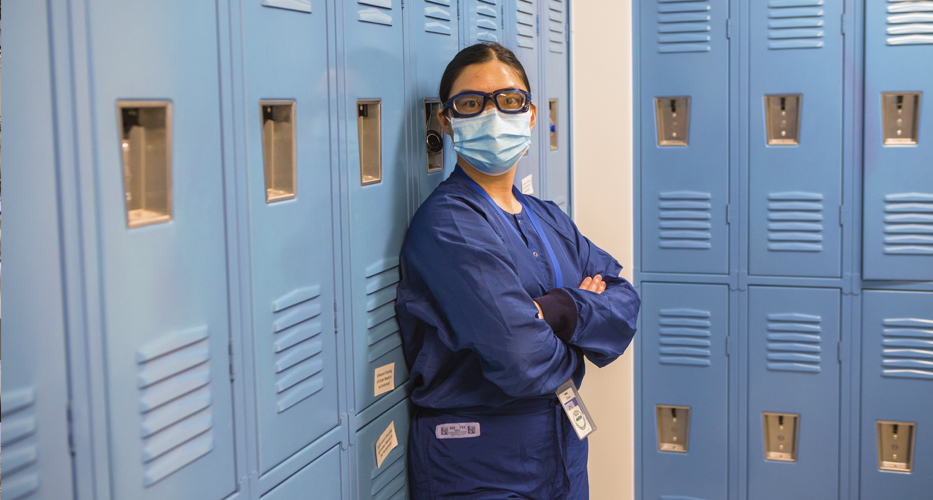
The locker room is where gowning to enter the manufacturing site begins. Drew Liu, like all who work inside the clean site, begins by changing out of street clothes and donning blue smocks, protective steel-toed shoes and removing all jewelry. Due to COVID-19, masks are worn at all times. Photo: Stacy Gleason.
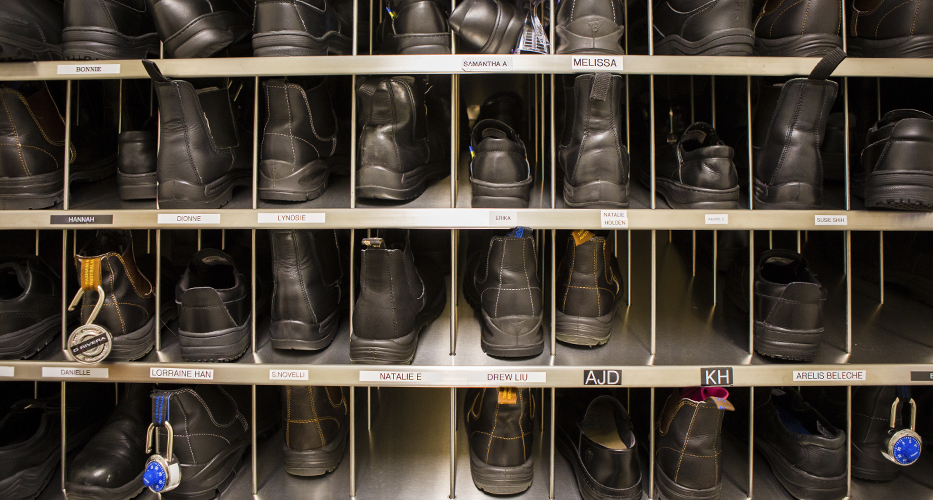
Steel-toed shoes are stored inside the locker room. Employees must wear them to enter the manufacturing site. Photo: Stacy Gleason.
Off come the shoes. Street clothes. Jewelry. It’s all stored in a locker and then Liu – who has been with Amgen manufacturing for two years – unseals scrubs and puts them on over undergarments. They look like surgical scrubs, draw strings around the waist and light and loose fitting.
Then come the steel-toed shoes already kept in the locker room. They never leave the site.
COVID-19 changed two key things during this process. Before, staff used shared eyewear protection at each shift. Now they bring their own. And masks are worn in the locker room now to help prevent the spread of COVID-19.
Liu is then ready for the next step in the layering process.
Stage Two
The room is like an airlock at a space station with a docking craft and this is where the COVID-19 impacts have been felt the most.
Only three people at a time are allowed in the waiting area, where hands are washed before entering a long, white room that Liu and others must go through. The result has been like closing down the freeway to one lane during rush hour. Liu said it takes about an hour during peak gowning time to get through this stage of the layering process.
It’s a one-person zone and there are markings on the floor that tell Liu exactly where she can stand.
Once the door is closed, it’s quiet in the room. Amgen designed the room so the air – though barely perceptible – is flowing against you. That’s so cleaner air from the inside of the manufacturing area is always moving less clean air back and out of the rooms.
Liu’s first act is to sanitize her hands again with a foaming hand sanitizer.
It isn’t unusual for those in manufacturing to have to bring a phone or laptop into work with them, but this is where they must be wiped down with the cleaner. Once wiped down, they are placed on a small table that is on the other side of a yellow line painted on the floor.
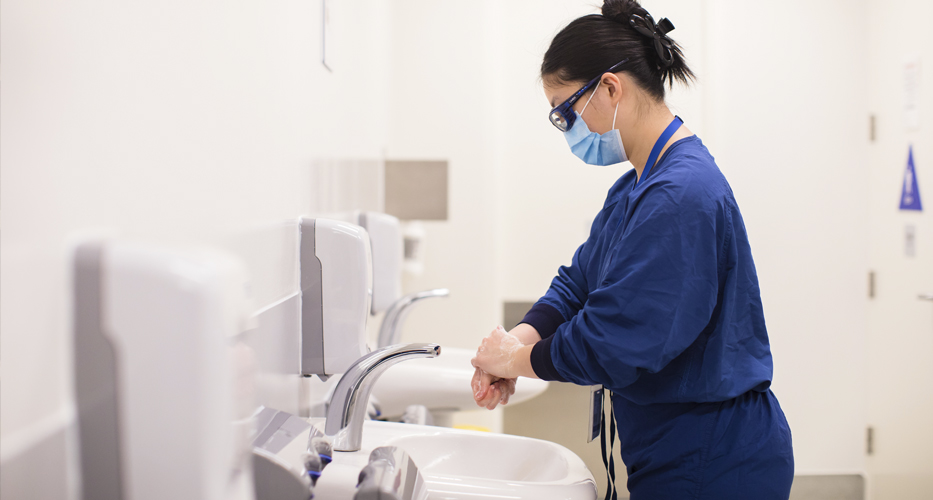
Drew Liu washes her hands in the second stage of gowning and decontaminating. Since COVID-19, this area is limited to one person at a time. Photo: Stacy Gleason.
Hairnet still in place, she disposes of the mask she wore in the locker room and replaces it with a new mask. Another round of sanitizing hands and then latex gloves are pulled from a dispenser and slid on to her hands.
This also becomes the first balancing challenge.
Liu slides her steel-toed shoe into a Bootie Butler and, once it’s on, carefully steps over the yellow line. Then on one leg, slides the other foot into the Bootie Butler and, once it’s over her shoe, places her other foot on the other side of the yellow line.
There is a mirror to check to make sure all the steps have been done. Liu is ready to pass to the next layer. Once she opens the door and it is closed, the next person is allowed in to go through that same process.
Balancing Act
It’s a short walk through a hallway to a small room with more painted lines and more balancing challenges.
Liu walks through a large door and when it’s closed, grabs another pair of shoe coverings. They look like space boots, but from the ankles to the below the knee, are made of a thin, white material.
There is a small bench for those who might not be ready to balance yet, but Liu is used to it by now. She slides one of the coverings over her steel-toed shoe and then places her foot across the painted line on the floor. Then, flamingo-like, slides the other shoe covering on and places both feet on the clean side of the line.
One can sit on the bench and put the coverings on and the line is close enough that you can put your feet on the clean side while sitting and then push your entire body up so your entirely on the clean side of the line. It’s not bad for the abs, either.
This is where it gets tricky.
White one-piece coveralls must be worn over the blue smocks. But at no point can any of the white coveralls touch the ground. Liu said most people use a technique where they bunch up the coveralls and hold the arms – which are most likely to touch the ground – and then slide one leg through while balancing on the other leg.
The trick, though, is to not let the leg portion touch the ground either, so it’s important to hold the pant leg that’s already on up while sliding the second leg through as well and then making sure to pull everything up to avoid any touching on the ground.
If anything touches the ground, you have to start all over again. Liu said they practice this ahead of time as a part of training to avoid contaminating the overalls during this process.
Once the overalls are on, those pant legs slide into the boots and are secured with a snap-fast device around the top of the boot. Sleeves are tucked into gloves and the gloves are sanitized again.
Liu is ready to enter the main working area now.
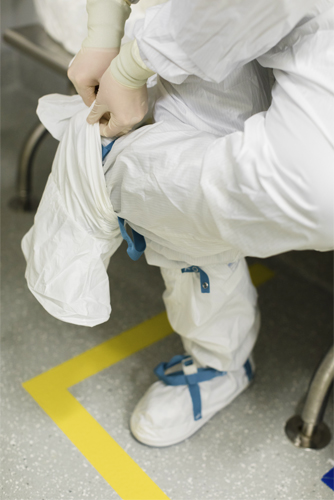
In the third stage of gowning, Drew Liu puts on protective boots to cover the steel-toed work shoes that were already covered with booties. This area is also marked by yellow lines that employees have to stay within and can't cross or move forward until properly gowned. Photo: Stacy Gleason.
But wait, more layers
There are two areas within this area of manufacturing where all of Liu’s layers simply aren’t enough protection.
The first area is where equipment is cleaned and sanitized. There is a large washer that, to rinse stainless parts, kettles and tanks off, requires Liu to don a heavy blue apron on top of her white coveralls and a pair of gloves over the gloves she has on already. Then there is a helmet with a face guard that goes over her mask and hairnet and protective glasses.
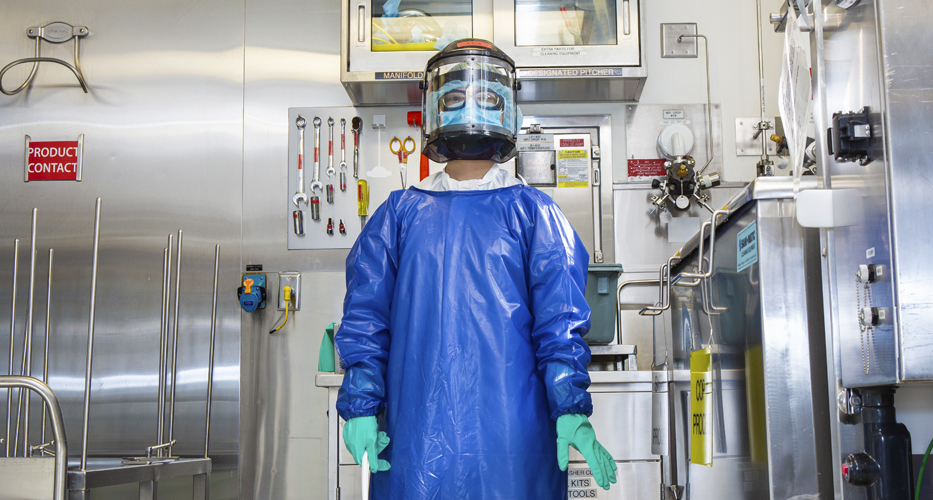
Drew Liu gowned in the equipment cleaning area. While this looks like the most layering Drew Liu wears inside the manufacturing site, it isn't permanent gear. Instead, it is only worn when equipment is cleaned. The heavy blue jacket and face shield are stored inside the equipment cleaning area and are removed once finished with washing equipment. Photo: Stacy Gleason.
The other area is where the cells are – Amgen’s core.
To enter this area, Liu opens the door and notes the yellow line on the floor that denotes the sides clean verses dirty.
First is a squirt of sanitizer on the gloves. Then grab another pair of boot covers. Same process as in the previous step – slip one boot cover on and place foot over the yellow line into the clean zone. Then slide the next boot cover on and, while balancing, touch down on the clean side with both feet.
Now comes the frock on top of the white coveralls.
It’s sealed and looks a bit like a white doctor’s coat – but thinner and lighter. It’s zipped up and then buttons at the top seal toward the neck. Then new gloves replace the old gloves.
And now one room remains.
Clean to the Core
Liu enters the room and this is where absolutely no mistakes can happen while layering with protection.
The clean room has cells growing in it. An incubator works quietly near an area where manufacturing operators can sit and record data. It’s a small room that can have four people in it at any given time.
New sterile gloves then replace the gloves already being worn. Then a second layer of sterile gloves is put over the first.
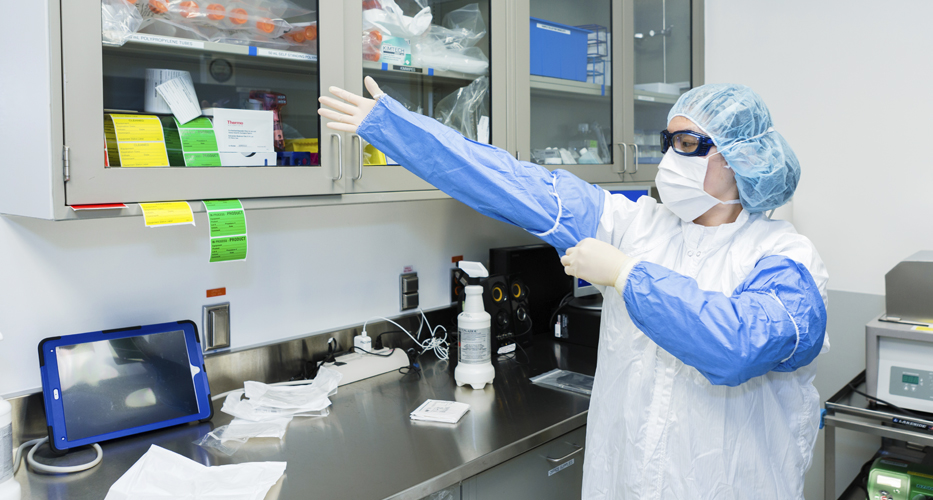
The epicenter and cleanest area of Amgen's manufacturing site requires the most layers. Drew Liu puts on protective sleeves that are in addition to two layers of gloves already on her hands. Photo: Stacy Gleason.
At this point, once Liu is in this area, it’s best to do as much as you can to avoid going through the whole process again. It’s also incumbent upon every person to try and be careful not to rip or tear any item of protection, in which case new gowning must be put on. She said after a while, she doesn’t think as much about the process of all the layers she is wearing – it’s just part of the job. But at the same time, it affects almost every decision made during the day related to things most take for granted, including going to the restroom or simply being hungry.
Leaving any area before a shift is over is like landing on a slide in the popular board game Chutes and Ladders where it takes you back and you have repeat layering up all over again.
“It makes you think about how badly you need to do something,” Liu said. “It had better be important.”
When the shift is over, the process of disrobing is far quicker – but caution is still observed. Layers are removed at the stages they were acquired and put into bins – all the way until the locker room where the final layer – which was the first layer – is disposed of with smocks being tossed into a bin.
But this is one last area where COVID-19 has changed things for the unforeseen future. One key layer of safety remains as Liu leaves the building.
Her mask.

